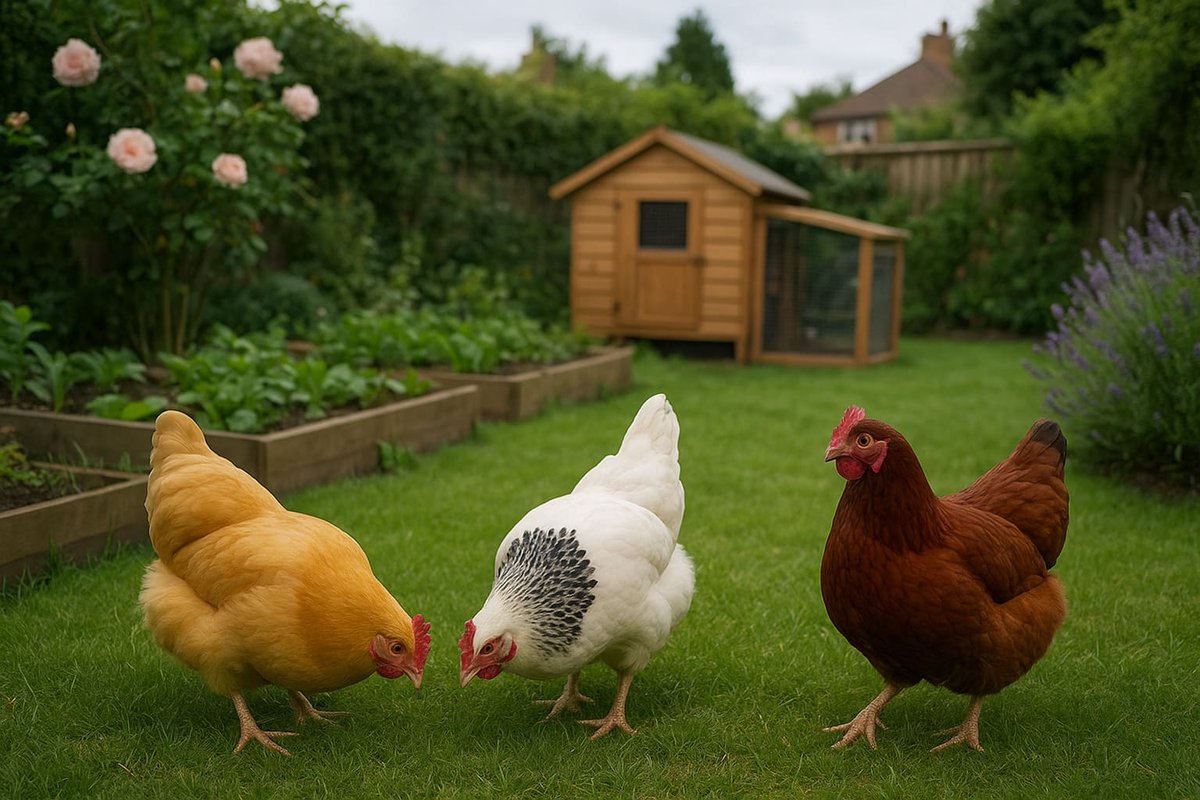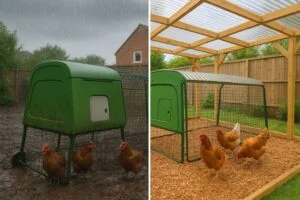This guide provides general information about keeping backyard chickens in the UK. Always check current DEFRA regulations and consult a veterinarian for health concerns.
“What is the best chicken for the garden?” It’s the first question every aspiring backyard poultry keeper asks. After keeping various breeds in my own small Yorkshire garden for over seven years, I’ve learned that choosing the right hen makes all the difference. Get it right, and you’ll have charming pets and fresh eggs. Get it wrong, and you’ll have a noisy, muddy mess and stressed-out birds.
Many people think all chickens are the same, but they’re not. Some are noisy, some are flighty, and some will destroy your lawn in an afternoon. For small UK gardens, you need specific traits: quiet, calm, and efficient.
This guide is my personal, experience-based breakdown of the best chickens for small gardens UK. We’ll cover the best egg laying chickens UK, the best chickens for beginners UK, and, crucially, answer the legal question: “Can I have chickens in my garden in the UK?“
Why Choosing the Right Chicken Breed Matters for UK Gardens
Choosing a chicken breed isn’t just about what colour eggs you want. In the UK, we have unique challenges: our gardens are often small, our weather is famously damp (which means keeping your coop dry in UK weather is a top priority), and we have a high density of urban foxes.
A breed that thrives on a multi-acre farm may be miserable in a small urban run.
Here’s what makes a breed “garden-friendly”:
- Temperament: You want docile chicken breeds. Aggressive or “flighty” hens are hard to manage, get stressed easily, and may try to escape.
- Noise Level: Your neighbours will thank you. Some breeds, like the classic Leghorn, are incredibly noisy. All the breeds on this list are known for being relatively quiet.
- Space & Foraging: Some breeds are happy in a secure run. Others need to forage all day and will become destructive and unhappy if confined. We’re focusing on breeds that adapt well to a smaller space.
- Hardiness: Our damp, cold winters can be tough. You need cold-hardy breeds that won’t get sick the moment the temperature drops.
Best Chickens for Beginners UK: What Makes a Breed Beginner-Friendly?
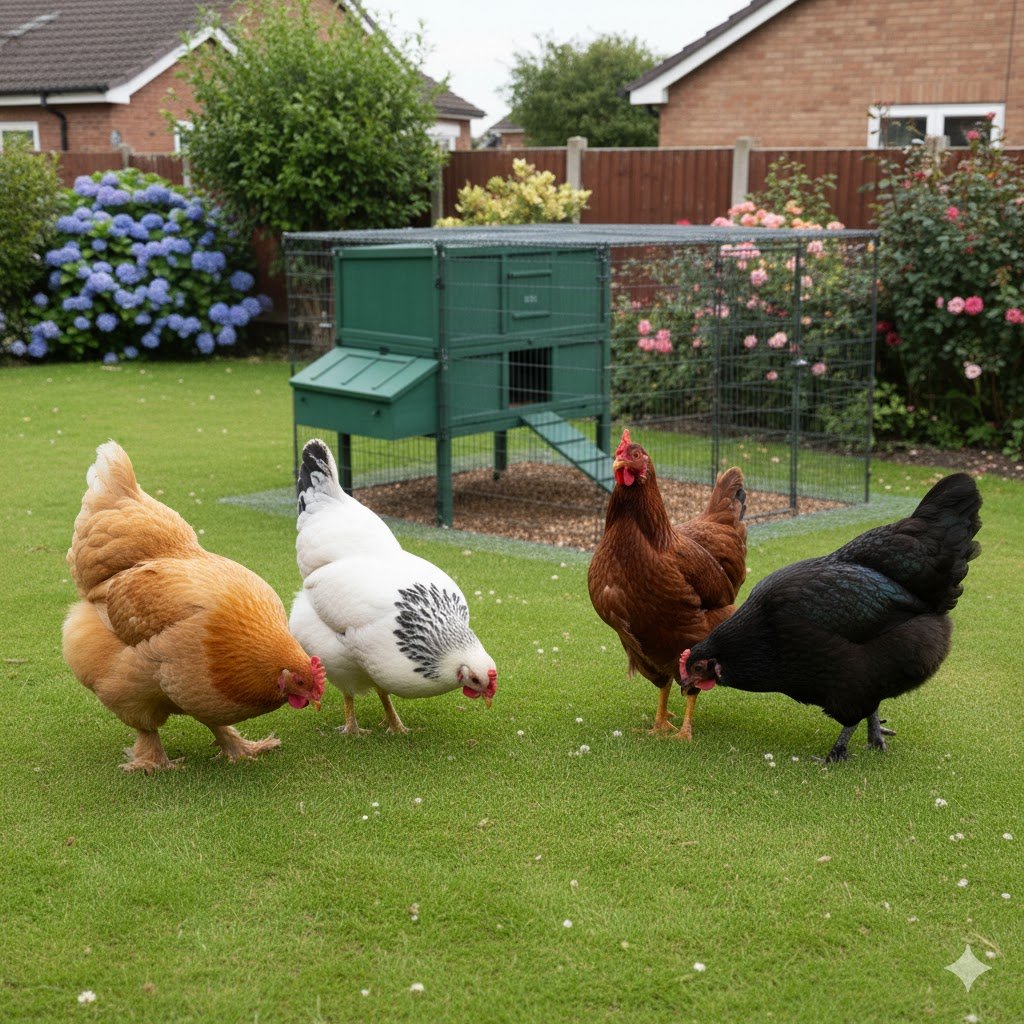
If you’re new to small space chicken keeping, your first priority is a “forgiving” breed. This means hens that are easy to handle, not prone to illness, and generally have a calm nature.
What to Look for in a Beginner’s Breed:
- Docile & Tameable: You want a hen that you can pick up if you need to, one that will happily eat from your hand and not panic every time you approach. This makes health checks and coop cleaning so much easier.
- Good Health & Hardiness: You don’t want to be running to the vet every five minutes. Robust, heritage breeds or hardy hybrids are best.
- Non-Flighty: A breed that’s happy to stay on the ground is key. You don’t want to be fishing your chickens out of your neighbour’s garden (or a tree).
- Not “Broody”: “Broodiness” is when a hen’s maternal instincts kick in, and she’ll sit on eggs (even unfertilised ones) for weeks, stopping laying and often becoming grumpy. Some breeds, like Silkies, are notoriously broody.
My top 3 picks for absolute beginners are the Buff Orpington, the Sussex, and the Rhode Island Red.
Common Beginner Mistakes to Avoid
- Buying “Pretty” Breeds First: I made this mistake. I fell in love with exotic-looking breeds that were noisy, poor layers, and bullied my other hens. Stick with the tried-and-tested breeds on this list for your first flock.
- Getting a Rooster: You DO NOT need a rooster for eggs. Hens lay eggs just fine on their own. Roosters are loud (they crow all day, not just at dawn) and are often banned by local councils. Don’t do it. (Here’s why you don’t need a rooster for eggs).
- Mixing Breeds Carelessly: Don’t mix very small bantams (like Pekins) with large breeds (like Orpingtons) in a small space. The bantams will get bullied (which requires managing pecking order problems).
- Underestimating Predators: You will have foxes. We’ll cover fox-proofing later, but don’t assume a flimsy latch will be enough. It won’t.
For more, check our guides on the easiest chicken breeds for beginners and common first-time chicken keeper mistakes.
8 Best Chickens for Small Gardens UK (Ranked)
Here are my top 8 breeds that are perfectly suited for a typical UK garden, based on my own experience and that of the UK backyard chicken community.
1. Pekin Bantam: What Breed of Chicken Stays Small?
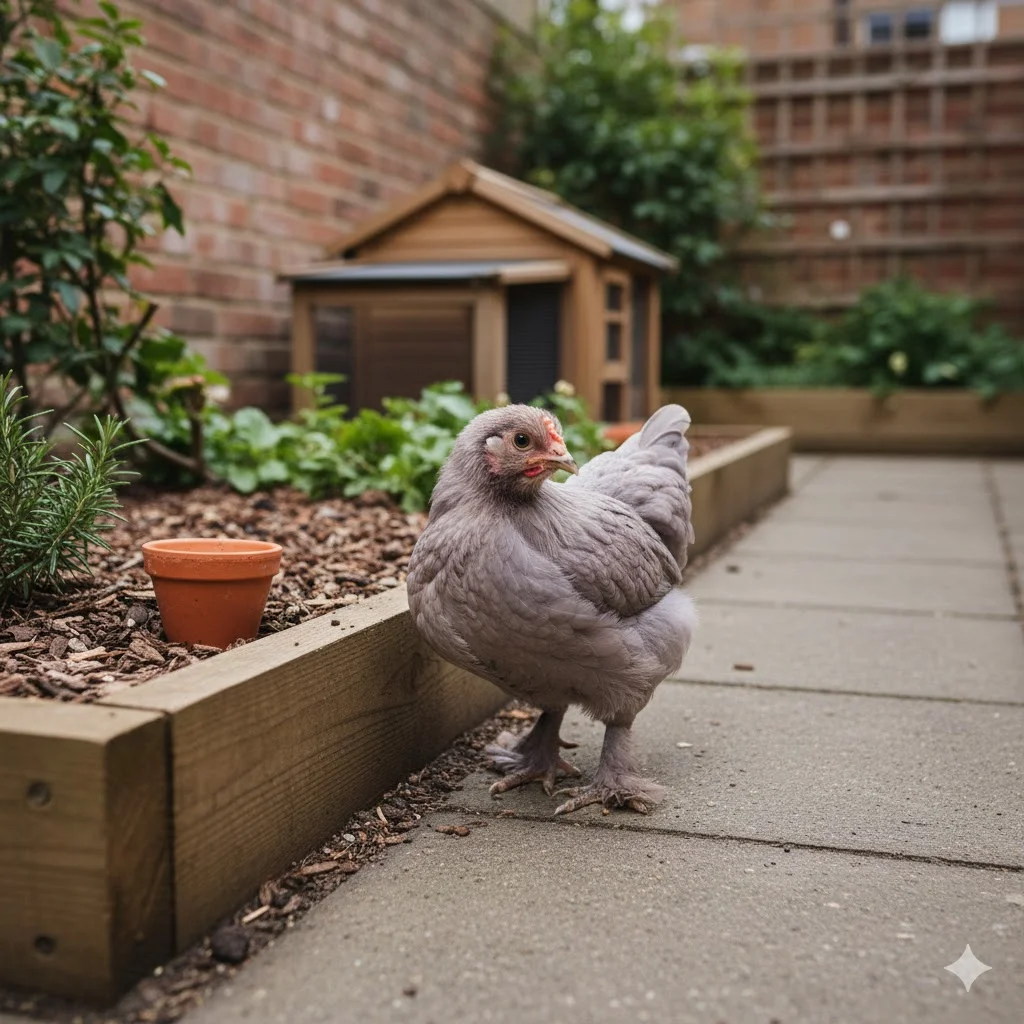
- Brief Description: If space is your biggest concern, look no further. The Pekin is a “true bantam,” meaning it has no larger counterpart. They are adorable, fluffy, and look like walking tea cosies.
- Size & Space: Tiny. They weigh around 600g (about 1.3 lbs). They are perfect for small space chicken keeping and urban chicken coops as they do very little damage to the ground.
- Eggs: Around 150 small, cream-coloured eggs per year.
- Temperament: Generally calm, friendly, and easy to tame. Their feathered feet mean they don’t scratch as destructively as other breeds.
- Cold Hardiness: Very good, their dense, fluffy feathers keep them warm.
- Best For: Tiny gardens, families with small children, keepers who value “pet” qualities over eggs.
- Considerations: They are prone to broodiness. Their feathered feet can get muddy and clogged in wet UK winters, so they need a clean, dry run.
2. Buff Orpington: The Gentle Giant
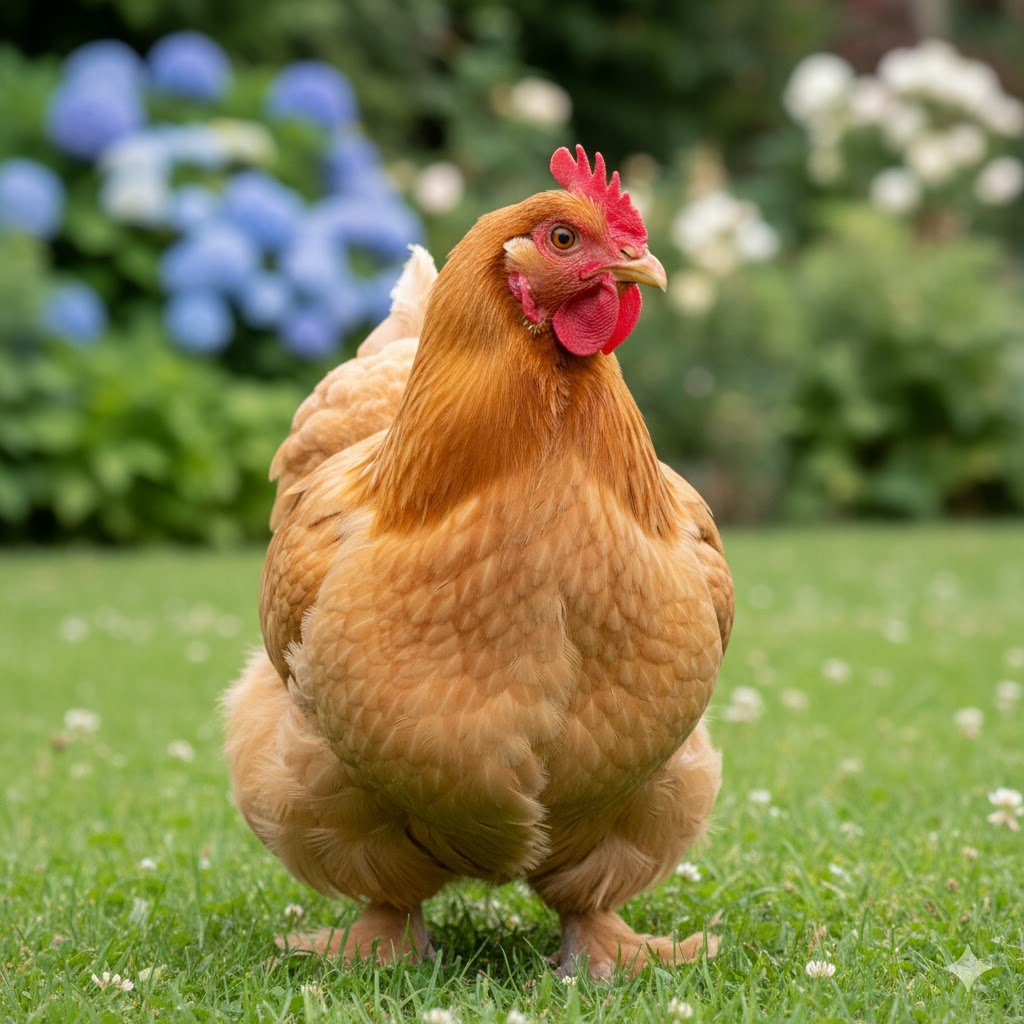
- Brief Description: The Buff Orpington is a “gentle giant” and a classic garden hen. They are big, beautiful, and one of the most docile breeds you can find.
- Size & Space: Large. They are heavy birds, which means they are not flighty and can be contained by a 3-foot (approx 1m) fence. They are happy in a secure run.
- Eggs: Around 180 large, light-brown eggs per year.
- Temperament: 10/10. Calm, friendly, and fantastic with children. They are the golden retrievers of the chicken world and will often follow you around the garden.
- Cold Hardiness: Excellent. Their dense feathering makes them perfect for UK winters.
- Best For: Beginners, families, and anyone wanting a genuinely friendly pet that also lays eggs.
- Considerations: Their size means they eat more and produce more poo. They can also get broody in the spring (here’s how to break a broody hen).
- Read more: Read our complete Buff Orpington breed guide for more.
3. Sussex (Light or Speckled): The UK Native
- Brief Description: A classic, dual-purpose British breed. The Light Sussex (white with black neck feathers) and Speckled Sussex are both beautiful and incredibly practical.
- Size & Space: Large. Like the Orpington, they are heavy and non-flighty. They are excellent foragers but also tolerate confinement in a good-sized run.
- Eggs: Excellent. Up to 250 large, light-brown eggs per year. A true layer hen.
- Temperament: Curious, friendly, and confident. They are not as “cuddly” as an Orpington but are very easy to manage and great for beginners.
- Cold Hardiness: Superb. They were bred for the UK climate and will lay reliably through a mild winter.
- Best For: The all-rounder. Great for beginners who want a friendly, cold-hardy breed with consistent egg production.
- Considerations: They are very food-motivated and can get a bit tubby if you overdo the treats.
- Read more: Read our in-depth Speckled Sussex guide for more details.
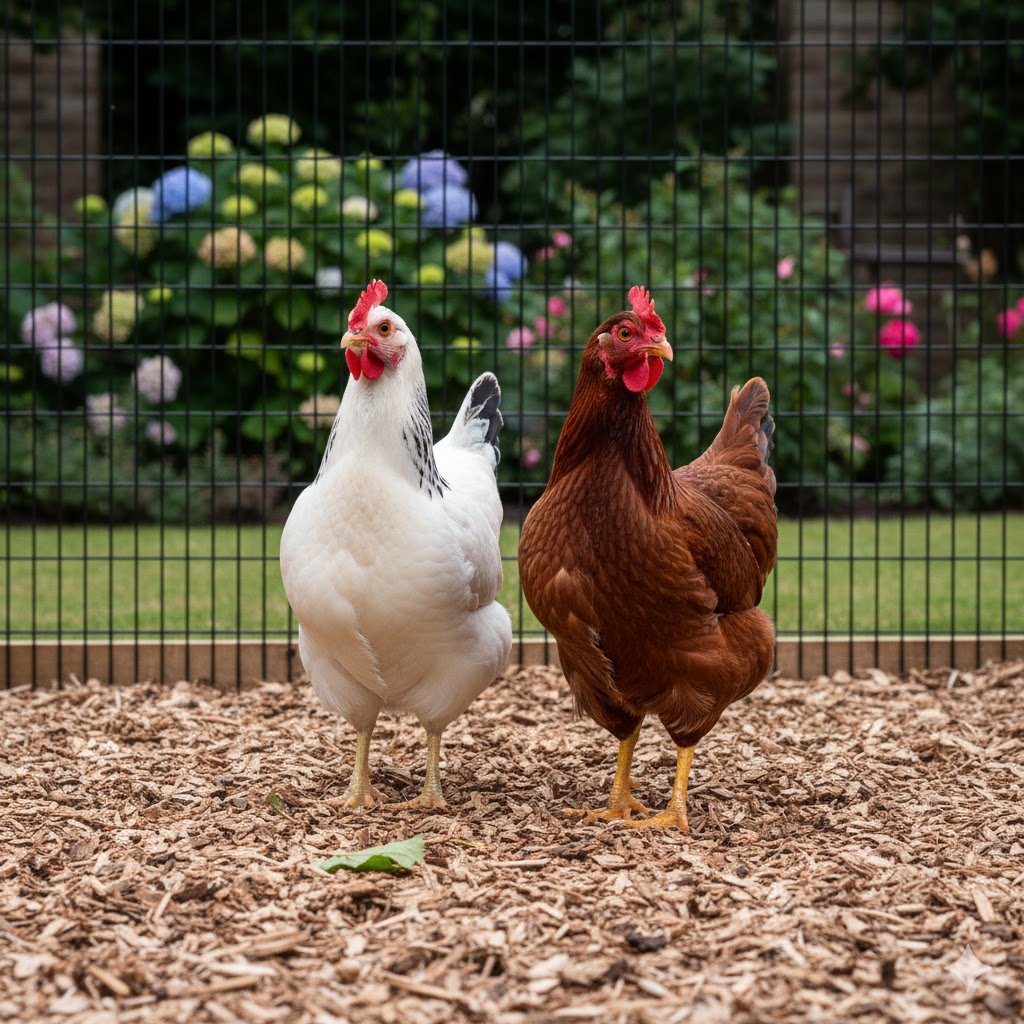
4. Rhode Island Red: The Egg-Laying Machine
- Brief Description: One of the most popular breeds in the world for a reason. These hens are robust, no-fuss, and one of the best egg laying chickens for beginners.
- Size & Space: Medium-Large. They are active birds that love to forage but will adapt to a run as long as they have enrichment (like a hanging cabbage).
- Eggs: Fantastic. Up to 300 large, brown eggs per year in their first year.
- Temperament: Generally good, but they are more “business-like” than an Orpington. They are confident and can be at the top of the pecking order.
- Cold Hardiness: Excellent. A very robust and self-sufficient breed.
- Best For: Beginners who are focused on maximum egg production from a hardy hen.
- Considerations: Make sure you get them from a good breeder. Poorer quality, “utility” strains can be flighty and more aggressive.
5. Wyandotte: The Fluffy Beauty
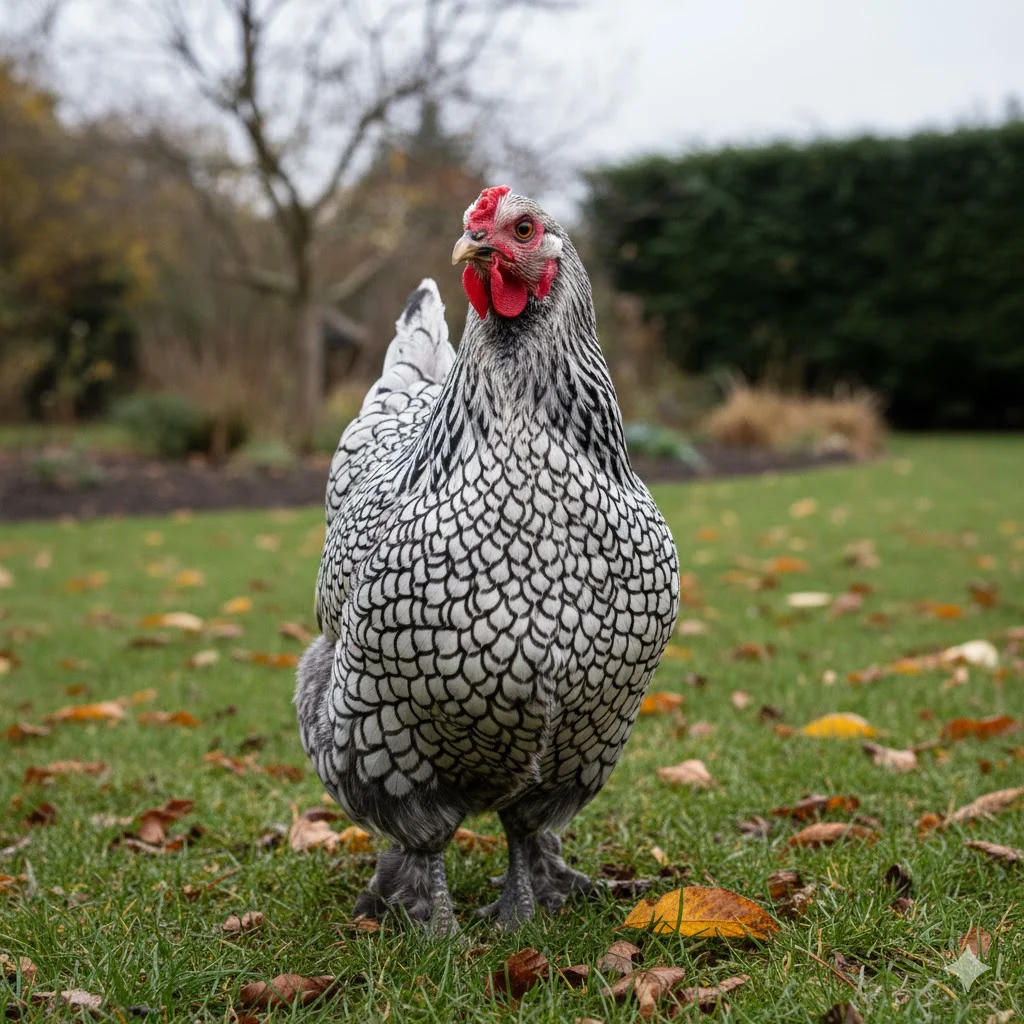
- Brief Description: Instantly recognisable by their beautiful, laced feather patterns (like silver-laced or gold-laced). They are a fantastic all-rounder.
- Size & Space: Large. They are heavy birds and not good fliers. They are happy in a run.
- Eggs: Around 200 light-brown eggs per year.
- Temperament: Generally calm and docile, but not as “pushy” as a Sussex. They are a good, gentle option for a mixed flock.
- Cold Hardiness: Excellent. Their “rose comb” (the flat comb on their beak) is less prone to frostbite (preventing frostbite on chicken combs is a key winter skill).
- Best For: Gardeners who want a beautiful-looking flock that is also practical and hardy.
- Considerations: Their fluffy bottoms can sometimes need a trim in wet weather to keep them clean.
- Read more: See our complete Wyandotte chicken guide to learn more.
6. Australorp: The Quiet Achiever
- Brief Description: A lovely Australian breed, related to the Orpington. They are known for being exceptionally quiet and very good layers.
- Size & Space: Large. Another gentle giant that is happy in a secure run.
- Eggs: Excellent. They hold the world record for egg-laying (364 eggs in 365 days!), but you can realistically expect 250+ large, brown eggs per year.
- Temperament: Very calm, gentle, and easily handled. They are a bit shyer than an Orpington but just as sweet-natured.
- Cold Hardiness: Very good.
- Best For: Urban or suburban gardens where low noise levels are a top priority.
- Considerations: Their dark feathers can make them harder to spot at dusk, so make sure they are all locked away safely from foxes.
- Read more: See our detailed Australorp breed guide to learn more.
7. Hybrid Layers (Warren, Goldline, ISA Brown)
- Brief Description: These are not traditional “breeds” but modern hybrids, cross-bred specifically for maximum egg production. They are the birds rescued by the British Hen Welfare Trust.
- Size & Space: Medium. They are very adaptable and were bred to live in confined spaces, so they cope well with a garden run.
- Eggs: Unmatched. 300-350+ eggs per year in their first year. They are the best egg laying chickens UK by a huge margin.
- Temperament: Varies, but generally docile and curious. Rescued hens, in particular, are incredibly endearing as they discover garden life.
- Cold Hardiness: Good, but their high-octane laying can take a toll, so they need good food and shelter.
- Best For: Anyone who wants the maximum number of eggs or the rewarding experience of rehoming ex-commercial hens.
- Considerations: Their laying drops off sharply after 2-3 years, and they can be more prone to health issues in later life. They are egg-layers, not long-term pets.
8. Plymouth Rock (Barred Rock): The American Classic
- Brief Description: A popular American heritage breed with a lovely “barred” black-and-white pattern. They are a fantastic dual-purpose bird.
- Size & Space: Large. They are solid, heavy birds that are easy to contain.
- Eggs: Around 200 large, brown eggs per year.
- Temperament: Calm, friendly, and very reliable. A great beginner’s bird.
- Cold Hardiness: Excellent. Another robust breed that just gets on with it.
- Best For: A classic, no-fuss garden hen that’s friendly and a consistent layer.
- Considerations: They are so reliable and “average” (in a good way!) that they sometimes get overlooked for flashier breeds.
- Read more: Read our White Plymouth Rock complete guide for more.
Comparison Table: Which Breed Is Right for You?
| Breed | Size | Eggs/Year (Approx) | Space Needed | Beginner-Friendly | Best For… |
|---|---|---|---|---|---|
| Pekin Bantam | Tiny | 150 (Small) | Very Small | ★★★★☆ | Tiny Gardens & Pets |
| Buff Orpington | Large | 180 | Medium-Large | ★★★★★ | Families & Beginners |
| Sussex | Large | 250 | Medium-Large | ★★★★★ | The All-Rounder |
| Rhode Island Red | Medium-Large | 300 | Medium-Large | ★★★★★ | Maximum Eggs |
| Wyandotte | Large | 200 | Medium-Large | ★★★★☆ | Beauty & Hardiness |
| Australorp | Large | 250+ | Medium-Large | ★★★★★ | Quiet Gardens |
| Hybrid Layer | Medium | 300+ | Medium | ★★★★★ | Egg Numbers & Rescue |
| Plymouth Rock | Large | 200 | Medium-Large | ★★★★★ | Reliability |
Best Egg Laying Chickens UK: Top Producers
If your main goal is a constant supply of fresh eggs, you want one of the high-production breeds.
- Top Choice (Hybrid): A Hybrid Layer like a Warren or Goldline is unbeatable. They are bred for one job: laying eggs. My rescued hens gave me an egg almost every single day for their first year with me.
- Top Choice (Heritage): If you want a traditional breed, the Rhode Island Red and Australorp are your best bets, both reliably producing 250+ eggs per year. The Sussex is a close runner-up.
A Quick Reality Check on Eggs
- Egg laying is not guaranteed. It slows down in winter (due to less light) and as the hen ages. (This is also why egg production drops during molting).
- A hen’s peak laying is in her first 1-2 years. After that, it will noticeably decline.
- You will get “weird” eggs! Soft shells, no shells, double-yolkers… it’s all part of the fun.
Best Chickens for Meat and Eggs UK: Dual-Purpose Options
In a small garden setting, “dual-purpose” usually means a larger, heavier bird that is a decent layer. The best dual-purpose birds on our list are the Sussex and the Plymouth Rock. They were traditionally bred for both their meat and their eggs, resulting in a solid, robust bird that is also a consistent layer.
Can I Have Chickens in My Garden in the UK? Legal and Practical Requirements
Yes, you absolutely can! But there are a few rules to follow.
- CRITICAL: DEFRA Registration (New Law): This is the most important rule. As of 1 October 2024, all poultry keepers in England and Wales must register their birds with APHA/DEFRA. This applies even if you only have one or two pet hens in your garden. It’s a free and simple online process designed to help track and control outbreaks of avian flu. Scotland has similar rules.
- Local Council Rules: Check your local council’s website (our comprehensive guide to keeping chickens in the UK has more on this). Most are fine with hens, but nearly all ban roosters in residential areas due to the noise.
- Property Deeds: Check your house or tenancy deeds. Some older properties have “covenants” that (rarely) forbid keeping livestock.
- Neighbour Considerations: Talk to your neighbours first! A well-kept coop with 3-4 quiet hens won’t bother anyone. A poorly-kept, smelly coop will. Good biosecurity measures (keeping things clean) are key.
- Space: The absolute bare minimum for coop space is about 0.37 m² (4 sq ft) per bird, but welfare groups recommend more. For run space, the RSPCA recommends at least 1 square metre (10.8 sq ft) per bird, but ideally 2 m² (21.5 sq ft) for small garden flocks to prevent stress and bullying. (See our detailed space requirements for chickens for a full breakdown).
How Much Space Do Chickens Really Need?
Forget the bare minimums. For happy hens, more is always better. My rule of thumb for a small garden is a minimum of 2 square metres (21.5 sq ft) of run space per bird. A 2m x 3m (6.5ft x 10ft) run is a decent size for three large hens.
You can get away with less if you let them out for supervised free-ranging in the garden every afternoon.
Can Chickens Roam Free in a Backyard? Safety and Garden Management
Yes, they can, and it’s the best part of keeping them! But you can’t just leave them to it.
- The Risk: Predators: In the UK, this means foxes. A fox will take your entire flock, day or night. Never let your hens roam unsupervised unless your garden is 100% fox-proof (which is very hard to achieve). (We also have guides on protecting your flock from birds of prey and the best predator deterrents for chickens).
- The Damage: Chickens will destroy your garden. They will eat your prize lettuces, dig up your flower beds to create dust baths, and poop on your patio.
My solution is supervised free-ranging. I let my hens out for an hour or two before dusk while I’m in the garden. They get to forage, it’s great fun to watch, and I can shoo them away from my veg patch before they lock themselves away for the night.
My 5-Step Fox-Proofing Checklist
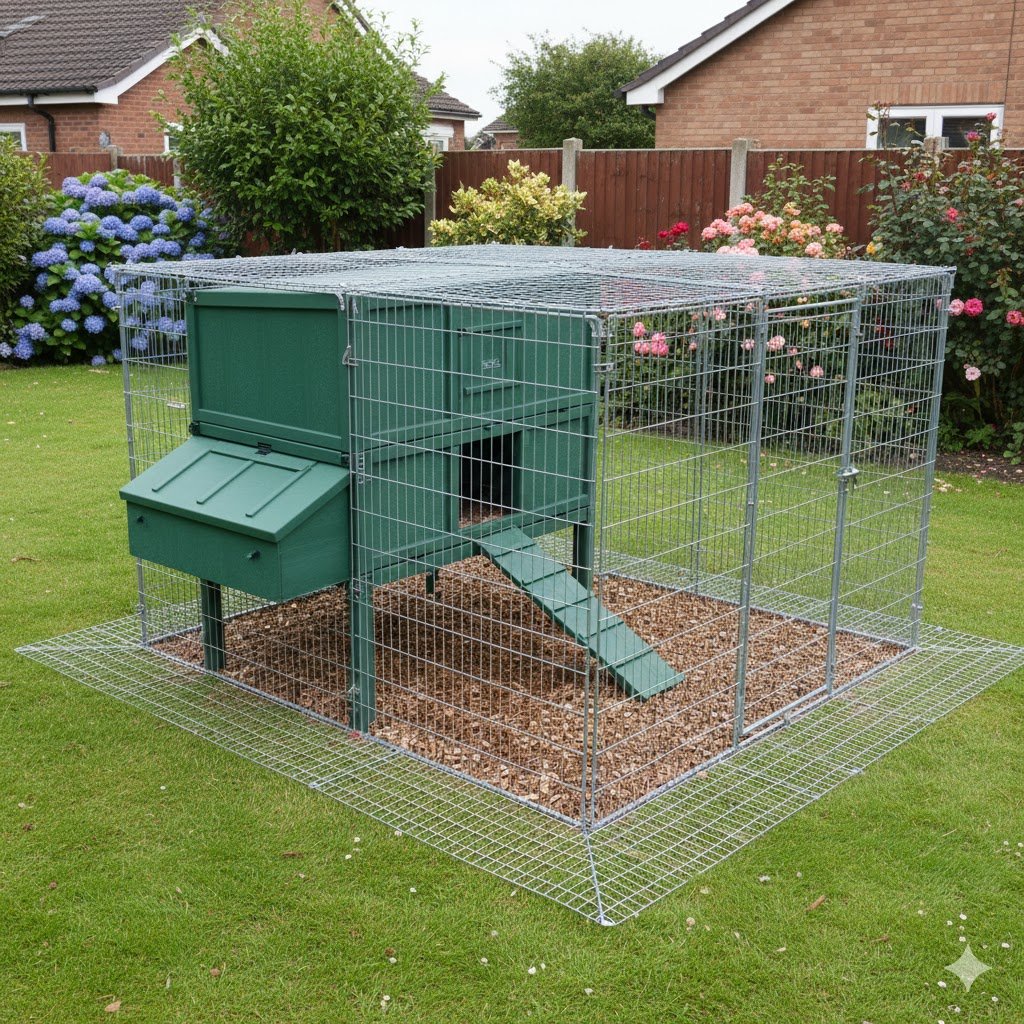
This is not optional. A fox will try. For a deeper dive, read our complete predator-proofing guide and our reviews of the best fox-proof chicken coops for UK gardens.
- Solid Bolts: Foxes are smart. They can flip a simple latch. Use proper sliding bolts or a padlock.
- Weld Mesh, Not Chicken Wire: A fox (or badger) can tear through standard chicken wire with its teeth. Use 1/2-inch galvanised weld mesh on all openings, including windows.
- The ‘Dig Skirt’: Foxes will dig. Lay a ‘skirt’ of weld mesh, at least 12 inches (about 30cm) wide, flat on the ground outside the perimeter of your run and peg it down. This stops them from digging under.
- A Solid Roof: A fox can climb. Your run needs a solid roof or one covered in weld mesh.
- Night-Time Routine: Lock your hens in their solid, wooden coop every single night without fail. This is their main protection. (Many keepers use one of the best automatic coop doors for UK keepers to automate this, which helps with getting chickens into the coop at night).
How to Protect Your Garden Beds (While Keeping Hens Happy)
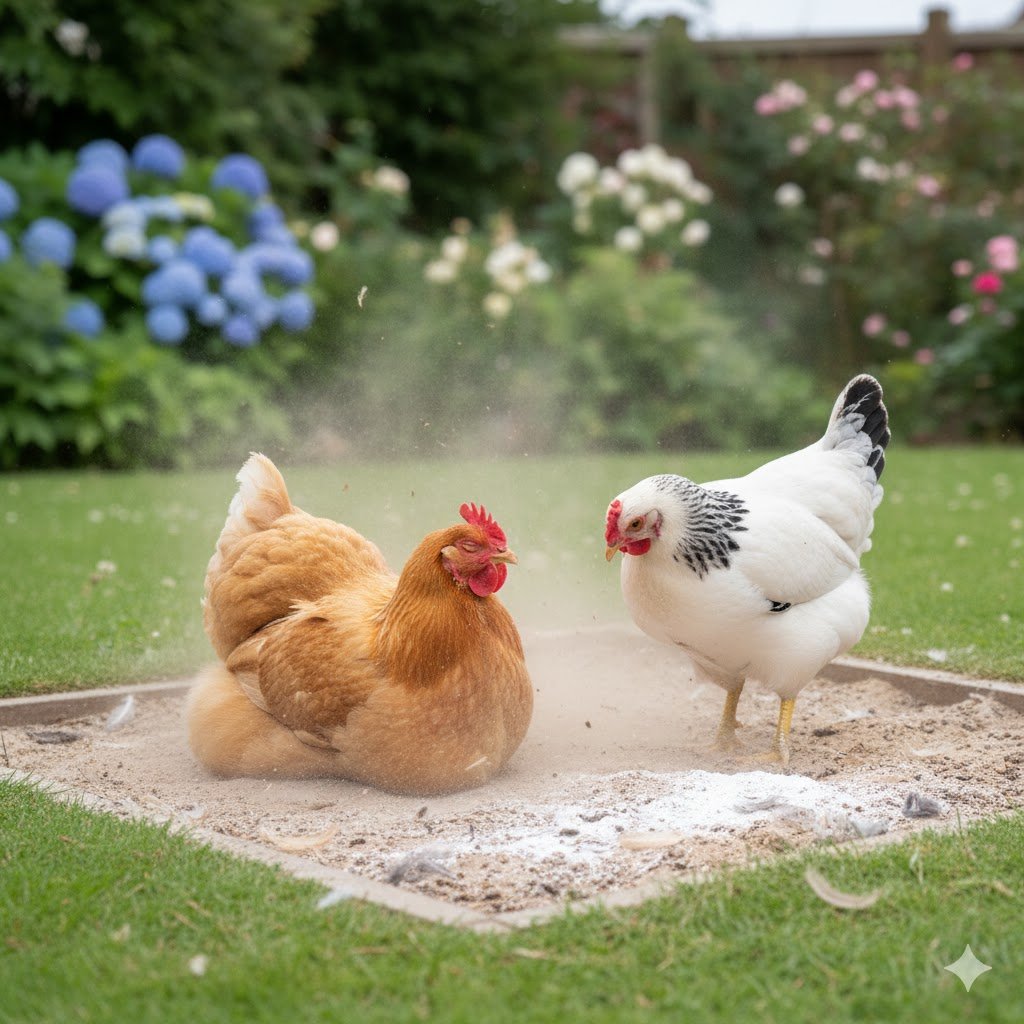
You can have both! Here’s how:
- Raised Beds: My number one tip. Chickens find it much harder to get up into and scratch out a raised bed.
- Low Fencing: A simple 2-foot-high (about 60cm) roll of chicken wire, loosely supported by stakes, is often enough to deter a heavy breed like an Orpington from your veg patch.
- A ‘Sacrificial’ Area: Give them their own spot to dig. A patch of bare earth mixed with sand makes a perfect dust bath and will keep them busy. (Here’s a guide on setting up a chicken dust bath).
Where to Buy Chickens UK: Trusted Sources and What to Look For
So, you’re ready to buy. Where to buy chickens UK is a key question. Please, do not buy from Gumtree, Facebook Marketplace, or a generic pet shop. You risk getting sick, un-sexed (i.e., you might end up with a rooster), or poorly-bred birds.
Types of Chicken Suppliers in the UK
- Registered Breeders: These are experts who focus on one or two heritage breeds. This is the best place to get a high-quality, healthy bird like a Sussex or Orpington.
- Hatcheries: These are larger-scale operations that sell hybrid layers and some pure breeds, usually as day-old chicks or “point-of-lay” pullets (see our guide on chicks vs. adult hens for beginners).
- Rescue Centres: The British Hen Welfare Trust (BHWT) is the main one. They re-home ex-commercial hybrid layers that are desperate for a second chance at life.
- Local Agricultural Suppliers: Places like farm shops or agricultural feed stores often sell point-of-lay hybrids.
Recommended UK Chicken Suppliers
- British Hen Welfare Trust (BHWT): My top recommendation. You save a life, and you get a hen that is desperate to enjoy a real garden. Note: Demand is very high. You will need to register on their website and should expect a waiting list, as rehoming days in each location happen every 4-6 weeks.
- Reputable National Suppliers: Look for established suppliers with good reviews that cover a wide area. For example, some businesses like Chickens to your Door have dedicated collection points across England and Wales, while others like Taylor Made Poultry offer a nationwide delivery service via specialist couriers.
- Local Breeders & Hatcheries: This is often the best choice for healthy, well-handled birds. Search for local breeders (like Hedgerow Henporium in Cheshire or Fulbrook Feathers in Buckinghamshire, as examples) or check the Poultry Club of Great Britain (PCGB) directory to find registered breeders of specific heritage breeds near you. This is almost always collection-only.
- Online Forums: The “Practical Poultry” forum and dedicated breed-specific Facebook groups remain great resources for finding small-scale local breeders.
A point-of-lay hen in the UK typically costs between £15 and £30, depending on the breed.
When to Buy: Seasonal Availability
Be aware that chickens are seasonal! While some hybrid suppliers offer hens year-round, the main season for buying point-of-lay (POL) hens is from March to October. This is when they are naturally reaching maturity and when you’ll find the widest selection, especially from smaller breeders. Plan to get your flock in spring or summer for the easiest transition.
Red Flags and My Golden Rule: Quarantine!
When you go to buy (be sure to learn performing a chicken health check), look for these red flags:
- Dirty, overcrowded pens.
- Birds that look lethargic, have droopy wings, or “bubbly” eyes.
- Anyone who won’t let you see the parent flock.
My Golden Rule: If you are adding new chickens to an existing flock, you must quarantine the new birds for at least 2 weeks. Keep them in a separate coop and run to watch for any signs of illness before introducing them.
Setting Up Your Garden for Chickens: A Quick Start Guide
You’ve got the breed, now you need the hen house setup.
Coop Essentials
- Go bigger than you think. A coop advertised for “3-5 hens” is comfortable for 3, max. (See our guide on how big your chicken coop should be).
- Red Mite Resistant: Red mites are tiny pests that hide in cracks and suck blood at night (a nightmare we cover in our guide to getting rid of red mites in wooden coops). Plastic coops (like Omlet or Nestera) are more expensive but are brilliant as they give the mites nowhere to hide.
- Ventilation: This is vital. You need vents high up (above their heads) to let damp air out, but no “drafts” at roosting level. (See our guide on proper coop ventilation requirements).
- Roosting Perches: Chickens sleep on perches, not on the floor.
- Nest Boxes: You need one nest box for every 3 hens, in a dark, quiet part of the coop. (Here’s our complete nesting box guide).
Run and Fencing
- This is their main living area. It must be 100% predator-proof (see my checklist above).
- A “walk-in” run (check our walk-in chicken run reviews) is more expensive but saves your back.
- Put a layer of woodchip down. (This is one of the best bedding for damp UK conditions). It’s great for foraging behavior, absorbs poo, and is easy to clean out. (This is key for fixing muddy chicken runs).
- Fencing: Your run must be secure. For larger areas, some keepers use electric fencing kits for UK chicken keepers as a backup.
What About Plastic Coops?
I’m a convert. My first coop was wood, and I spent every summer fighting a losing battle against red mite. I switched to a plastic Omlet Eglu Cube (read my detailed Omlet Eglu Cube review), and my problems vanished overnight. They are easier to clean and last a lifetime. They are a big upfront investment but worth it, in my opinion. (We also have an Omlet vs. Framebow comparison if you’re weighing options.)
FAQ: Your Quick Questions Answered
How many chickens can I keep in a small UK garden?
For most urban gardens, 3-4 hens is the perfect flock size. It’s a manageable number, you’ll get 2-4 eggs a day in their prime, and they won’t overwhelm the space. (This also depends on your family size; see how many chickens for a family of four).
Do I need a rooster for hens to lay eggs?
No. A hen will lay eggs regardless. You only need a rooster if you want to hatch fertilised eggs to get chicks.
How much do chickens cost in the UK?
A point-of-lay hen costs £15-£30 each. A decent, fox-proof coop and run setup will cost anywhere from £300 to £800.
What do chickens eat in the UK?
Their main diet (90%) should be a commercial “layers pellet” or “layers mash.” This has all the nutrients they need. The other 10% can be treats like corn, greens, and supervised garden foraging. (Check our comprehensive chicken feeding guide and reviews of the best UK poultry feed brands).
Will chickens destroy my garden?
Yes, if you let them. They will dig up plants to create dust baths and eat anything that looks tasty. Use the “supervised free-range” method (see our chicken run vs. free-range comparison) or fence off your precious plants.
Do chickens need a heat lamp in UK winter?
No. Cold-hardy breeds (like all the ones on this list) handle UK winters just fine. A heat lamp is a fire risk and isn’t necessary. The key is a draft-free but ventilated coop that stays dry.
How much time do chickens need per day?
Not as much as you might think! Daily care takes about 5-10 minutes. This involves letting them out in the morning, checking their food and water, collecting eggs, and locking them up securely at dusk. You’ll need another 20-30 minutes once a week for a quick clean of their coop (here’s how to start keeping your coop clean and odor-free).
Do chickens attract rats?
This is a major concern for many, but the answer is: chickens don’t attract rats, their food does. Rats are drawn to easy meals. You can easily prevent them by storing all your chicken feed in a metal (rat-proof) bin with a secure lid and, most importantly, bringing the feeder in at night or using a treadle feeder that rats can’t access. (We have a full guide on keeping rats away from your chicken coop).
What about health and hygiene, like Salmonella?
This is a key part of biosecurity. Always wash your hands with soap and water after handling your chickens, collecting eggs, or cleaning the coop. Supervise children and don’t let young kids kiss or snuggle the birds. For a full guide on hygiene, check the CDC’s advice on backyard poultry safety, as the health rules apply in the UK too.
What can’t chickens eat?
Chickens can eat most kitchen scraps, but some foods are toxic. The main ones to avoid are: chocolate, avocado (especially the skin and pit), raw or dried beans, mouldy food (which can cause lung infections), onions, and rhubarb leaves. Stick to greens, cooked pasta/rice, and grains. (Here’s a list of safe kitchen scraps for chickens).
Can chickens live in a shed?
Yes, a standard garden shed can be converted into an excellent coop! You will need to make sure it’s predator-proof (especially the floor and any windows), add ventilation (high up, away from where they roost), and install perches for them to sleep on and nest boxes for laying. (See our post on alternative housing options for chickens).
Ready to Start Your Flock?
Choosing the right chicken for your garden is the most important step. For most UK beginners, my top recommendation will always be a Sussex or a Buff Orpington. They are the perfect combination of friendly, hardy, and productive.
Whichever you choose, the rewards are fantastic. There is nothing better than collecting your own fresh eggs on a sunny morning from a flock of happy, clucking hens.
Good luck, and welcome to the brilliant hobby of backyard poultry keeping! If you have any questions, drop them in the comments below.

Oladepo Babatunde is the founder of ChickenStarter.com. He is a backyard chicken keeper and educator who specializes in helping beginners raise healthy flocks, particularly in warm climates. His expertise comes from years of hands-on experience building coops, treating common chicken ailments, and solving flock management issues. His own happy hens are a testament to his methods, laying 25-30 eggs weekly.
